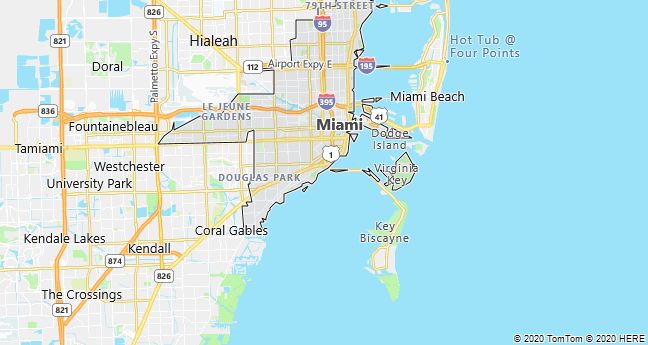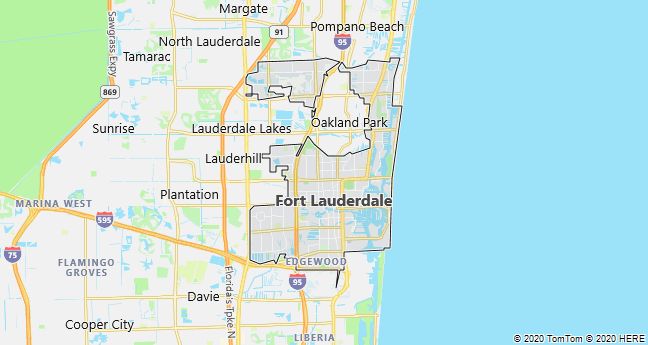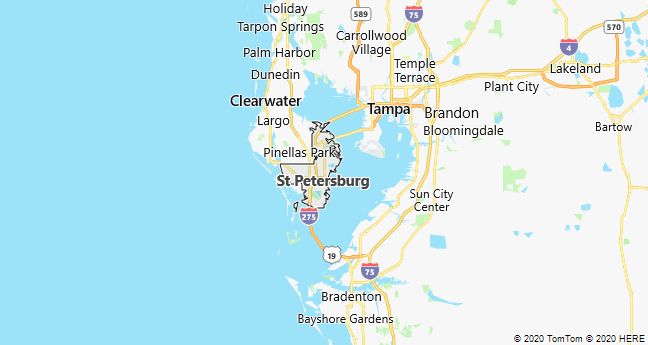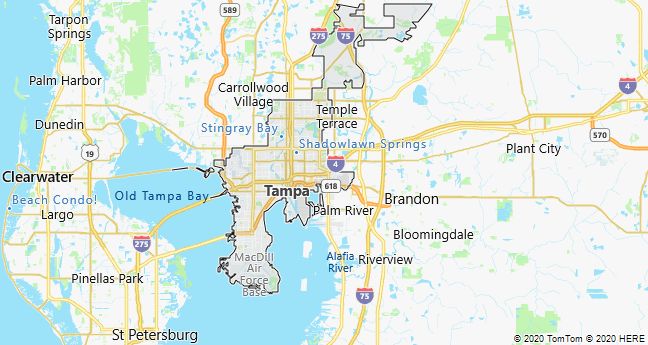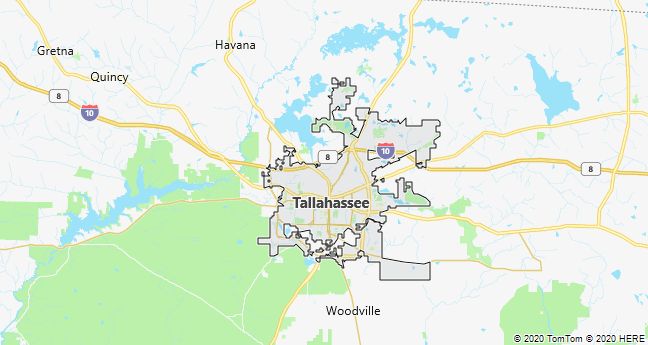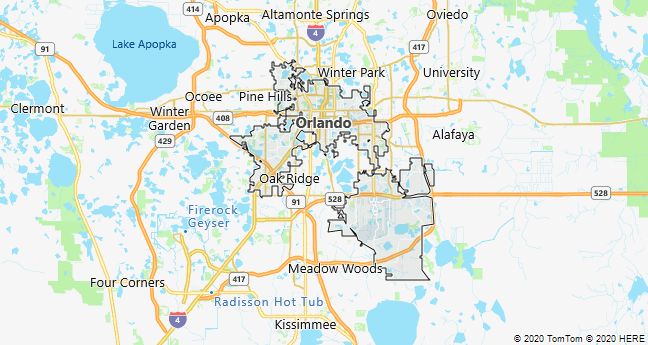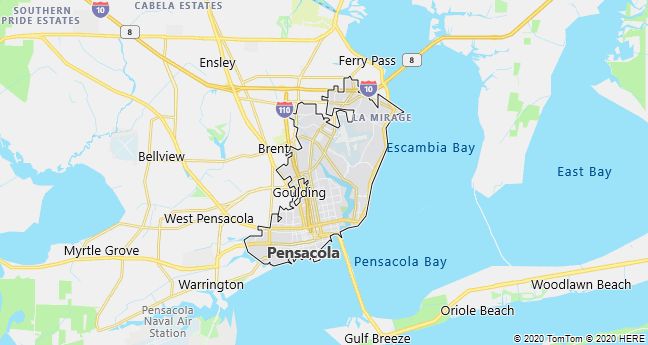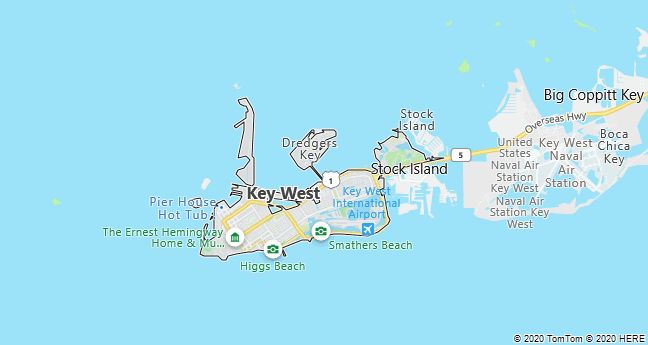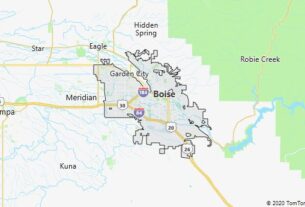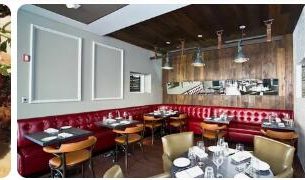Jacksonville
Jacksonville, port city at St. Johns River in northeast Florida, USA; 821,800 residents, of which 31% are black (2010). It is one of Florida’s largest industrial cities (especially paper, chemicals, and food), but is also an important educational, convention, and business center. Following expansion of the city limits in 1968 includes metropolitan area almost throughout Duval County (2142 km2), including several resort towns on the Atlantic coast, The Jacksonville Beaches and Naval Base Mayport Naval Station. Large parts of the city, which were founded in 1816, were destroyed by fire in 1901. 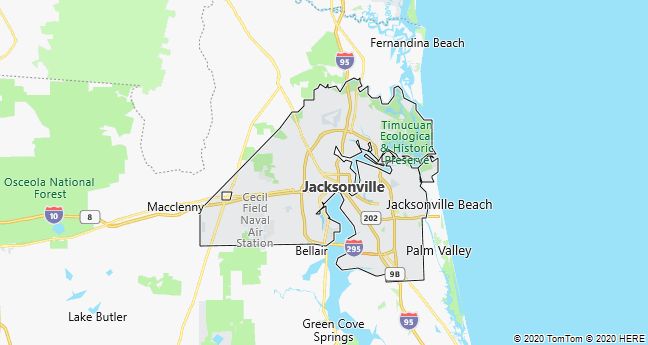
Miami
Miami, a city on the Atlantic Ocean in southeastern Florida, USA; 399,500 residents (5.5 million in the metropolitan area), of which 19% blacks and 70% Hispanics. (2010).
The town’s history dates back to Spanish missionaries in the 16th century, but the turning point came in 1896, when the rich man Henry Flagler (1830-1913) brought the railway here and subsequently built hotels and expanded the harbor. This established tourism, which with its center in Miami Beach is the city’s most important asset with approximately 8 million visitors per year; many use, especially during the winter months of Miami, the Cruise Capital of the World, as a base for cruises in the Caribbean.
Miami’s subway system consists of a 34 km long elevated railway and the driverless light rail, Metromover, in the city center.
The population growth has at times been very large, in connection with large land acquisitions in the 1920’s, the Florida Land Boom, and after the Cuban revolution in 1959. Together with other immigrants from Latin America, Cuban refugees and immigrants have since 1980 increased the population by almost 2 million. The Latin American touch is most clearly seen in the urban districts of Little Havana and Little Haiti, but also characterizes banking, finance and foreign trade. In addition, a growing film and television industry that became world famous in the 1980’s with the series Miami Vice (Miami Patrol), which was often based on the city’s criminal environment with its infamous drug trade.
By virtue of Jackson Memorial Medical Center and the University of Miami have reputable research centers in addition to the aerospace, aerospace, and food industries. The climate is tropical-humid with pleasant winter temperatures; gnsn. for January and July are respectively. 19 °C and 28 °C. In late summer, the coast is regularly hit by tropical cyclones. The most devastating to date was “Andrew”, which in August 1992 left 220,000 people homeless and caused damage to more than 25 billion people.
Fort Lauderdale
Fort Lauderdale, a city in Florida 40 km north of Miami; 165,500 residents (2010). Like other cities along the Florida Gold Coast, it is a distinctly tourist city, but also home to resident business people and wealthy retirees. In addition to numerous nightclubs, hotels and entertainment centers, including a giant gaming hall owned by Seminole Indians (The Hollywood Bingo Empire), the city has a number of fine museums. This includes the Museum of Art, which with a large number of works by Asger Jorn, Carl-Henning Pedersen and other Cobra painters has one of America’s largest collections of modern painting. Since the 1930’s, the city has also been a gathering place for competitive swimmers, and in The Swimming Hall of Fame, the Danish-born canal swimmer Greta Andersen is seen side by side with Johnny Weissmuller and other world stars.
Saint Petersburg
Saint Petersburg, resort town on Tampa Bay on the west coast of Florida, USA; 244,800 residents (2010). After the railway connection in 1888, the climatically attractive town with its long sandy beaches became a popular haunt for pensioners, who today make up the majority of the resident population. The sights include the Salvador Dalí Museum with a collection of over 1000 works by the Spanish painter.
Tampa
Tampa, a port city on the west coast of Florida, USA; urban population 335,700 (2010), in the Tampa-St. Petersburg-Clearwater 2.7 million The city’s position as an economic center in West Florida was founded with the railroad in 1885, followed by port facilities, hotels, and more. citrus and fertilizer industry; in addition, cigar production, which has roots in Cuba, quickly attracted many Latin Americans. Several of the old industries are still important, although the growth in recent decades is mainly due to high-tech companies associated with e.g. the aerospace industry. To the south is MacDill Air Force Base, which was the headquarters of the American bombings during the 1991 Gulf War.
Tampa attracts many domestic visitors, and it has become an international tourist destination via air routes and cruise ships. Attractions include the historic Ybor City Cigar District and the Busch Gardens theme park.
Tallahassee
Tallahassee, the capital of Florida, USA, in the northern part of the state; 181,400 residents (2010), of which 35% are black. The city is an administrative and educational center with approximately 25,000 university students. The economy is based on processing and trade in agricultural and forestry products (cotton, cattle, timber). Attractions include the Museum of Florida History and the Old Capitol Building (1839-1977).
Daytona Beach
Daytona Beach, North Atlantic Coast Resort in North Florida, USA; 61,000 residents (2010). Kilometer-long bathing beaches attract millions of bathers every year. Until the opening in 1959 of the Daytona International Speedway with 150,000 spectators, the beaches were also used for motor racing and as a test track for racing cars.
Orlando
Orlando, a city in central Florida, USA; city population 238,300, in the urban region 2.1 million residents (2010). The town was laid out in 1856 and developed after the railway connection in 1880 into a center for agricultural goods (especially citrus fruits). Since World War II, it has had an influx of electronics companies affiliated with the aerospace industry, but has been particularly affected by tourism since the opening in 1971 of Walt Disney World 40 km SW of downtown. Later, other large amusement parks were built in the area, which together with hotels, shopping centers, golf courses, etc. make southern Orlando one huge tourist area. In addition, both Disney-MGM Studios and Universal Studios of Florida (both opened in 1990), in addition to being major attractions, are also some of America’s most prolific film and television studios.
Pensacola
Pensacola, a town in northwest Florida, USA, on the Gulf of Mexico; 51,900 residents (2010). In addition to port activities, tourism and industry (artificial fibers, chemicals, etc.), the city is characterized by Pensacola Naval Air Station. Attraction, The Historic Pensacola Village houses museums and well preserved houses from the city’s heyday around 1900, and off the coast excursion goal Santa Rosa Island, a barrier island with beautiful sandy beaches. To Pensacola’s tumultuous history belongs that it since the 1500’s. has been in Spanish, French and British possession before it, along with the rest of Florida, became American in 1821.
Saint Augustine
Saint Augustine, a town on the Atlantic coast of northeast Florida, USA; 13,000 residents (2010). The city was founded by the Spaniards in 1565 and is the oldest preserved European city in the United States. Attractions include the Castillo de San Marcos fortress and the museum-like old town. The economy is based on tourism, which began after oil magnate Henry Flagler (1830-1913) brought the railroad here and built the luxury hotel Ponce de León, now Flagler College.
Palm Beach
Palm Beach, a city on the Atlantic Ocean in southern Florida, USA; 8348 residents (2010). The town, located on a barrier island with wide sandy beaches, is by bridges connected to the neighboring town of West Palm Beach (99,900 residents). Since the renowned Henry Flagler in the 1890’s brought the railroad here and built the first luxury hotels, Palm Beach has evolved into a pretentious and exclusive resort. Flagler’s private palace residence, Whitehall, is now housed as a museum, and the city is home to the PGA (Professional Golfers Association) headquarters.
Key West
Key West, a port city on the westernmost of the islands in the Florida Keys, USA; 25,500 residents (2010). The city is characterized by a distinctive blend of Caribbean and American culture, which has attracted many artists. In the Old Town district, there are well-preserved wooden houses from the heyday of the 1800’s, when the town profited from extensive piracy and smuggling; later also by cigar making and fishing (sponges, turtles, shellfish).
After the Depression of the 1930’s, the city received an economic boost with the expansion of the US Navy during World War II, just as Cuba’s proximity (only 140 km) later brought it into the spotlight of the CIA. The sights include a museum decorated in the author Ernest Hemingway’s residence 1931-61.
